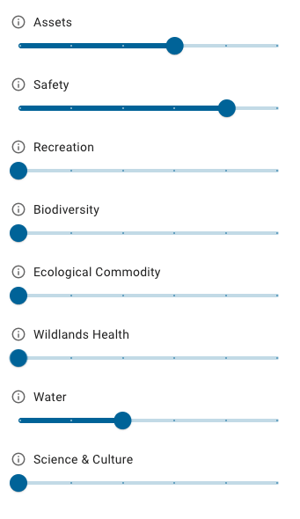Emphasize Management Objectives
Learn about the emphasis objective sliders
Vibrant Planet helps you build prioritized projects based on the management objectives you and your partners choose to emphasize. There are 8 objective categories you can emphasize. All SARAs fall into the following one of the follow 8 objective categories:
- Assets - homes, businesses, and utility infrastructure
- Safety - ingress and egress routes, cellular communication towers, and emergency services
- Recreation - trails and recreation related buildings
- Biodiversity - known nesting and denning areas, important habitat, and rare plant areas
- Ecological Commodity - managed timberlands and mining claims
- Wildlands Health - areas of high aboveground biomass, riparian areas, and wetlands
- Water - lakes, rivers and streams, and erosion potential
- Science & Culture - scientific test plots, sites of cultural significance, and monitoring stations
These objectives incorporate the base SARAs included in every Vibrant Planet landscape, as well as any of the custom SARAs you may have added to the platform. If an objective has no SARAs on your landscape, it will not appear in the platform.
Emphasizing Objective Categories

Each objective category can be weighed up to five times higher than other categories. A weight of zero means that the objective category’s RO score would not impact where projects are identified, and a weight of a five means that an objective category's RO score would be weighted five times higher than an objective with a weight of one.
For example (pictured right) a user may build a scenario in which safety is prioritized three times greater than Assets, two times greater than Water, and nothing else is being prioritized.
Vibrant Planet helps make the comparison of these objectives possible. As partners weigh their objectives, the platform maps the highest opportunities for resilience opportunity on a per-acre basis. The darker the blue polygon, the higher the opportunity to increase resilience, based on that objective. As objectives shift, the maps shift.
In the following examples, you can see how three groups are able to emphasize different objectives:
- Group 1: Fire district - Prioritize assets and safety 5 times higher than all other objectives

- Group 2: Climate change nonprofit - Prioritize wildlands health and water 2 times higher than all other objectives

- Group 3: Forest service - Prioritize assets and safety 3 times higher, and recreation and water 2 times higher than all other objectives

As you can see, the opportunity to increase resilience is similar but not identical across these three examples.
In the next section, we’ll explore how the platform utilizes these collaborative priorities to create a sequenced, prioritized plan.
.png?width=800&height=147&name=VP_Logo_Horiz_Color_RGB%20(4).png)